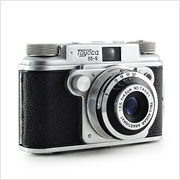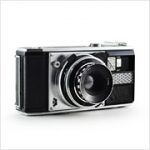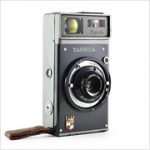Toyoca 35-S Specifications
| Manufacturer: | Toyohashi Y.K. Tougodo |
| Origin: | Japan |
| Made in: | Toyohashi, Aichi, Japan |
| Introduced: | 1957 |
| Type: | Viewfinder |
| Format: | 135 Film |
| Dimensions: | 12.4 x 7.8 x 6.2 cm |
Toyoca 35-S Overview
The Toyoca 35-S (also sold as the Strato 35) is a 35mm viewfinder camera introduced by Toyohashi Y.K. Tougodo in 1957 under the brand name Toyoca, a contraction of “Toyohashi” (where the company was based) and the English word “Camera.” The name “Tougodo,” on the other hand, was in honor of one of Japan’s most famous naval heroes, Admiral Togo Heihachiro who was born in the same city as one of the company’s founders.
There are actually two distinct models of Toyoca 35-S, the one you see here uses standard 35mm cartridges while the other variation used the then-popular unperforated, paper-backed 35mm film cartridges developed by the German camera manufacturer Bolta. Both cameras are more or less identical with the only real difference being a red window located on the film door of the second version.
The Toyoca 35-S is fairly well equipped for a 35mm camera of its day. The inner-most ring surrounding the front element is used to focus the camera’s lens—a 45mm f/3.5 Tri-Lauser Anastigmat. The next ring out is the shutter speed selector with options ranging from 1/25 to 1/300 seconds and Bulb. A shutter cocking lever can be found at 11 o’clock on the shutter speed ring with the aperture selector just behind it. The round shutter button can be found just off to the side of the lens at the 10 o’clock mark with a threaded cable release socket just above it. A flash sync socket can be found on the opposite side at two o’clock.
On the user’s left hand side of the top plate is a manually-set film speed indicator set into the top of the film rewind knob. Going to the right, you find a cold shoe, an automatic frame counter, and the film advance knob. Located on the back next to the viewfinder window is a film rewind release lever above the film advance release button (to make sure you don’t wind the film accidentally).
I bought this 35-S through an eBay auction, mostly because I didn’t want my Toyoca Six to be lonely. While I haven’t come across as many Toyoca cameras as I’d like, I’ve become pretty fond of them and look forward to adding more to my collection.
Find your very own Toyoca 35-S on eBay.
McKeown, James M. and Joan C. McKeown’s Price Guide to Antique and Classic Cameras, 2001-2002. (Grantsburg, WI, USA: Centennial Photo Service, 2001), p 639, 641.


















